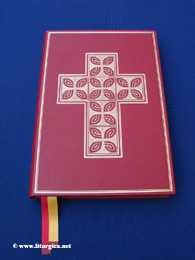Measurments, Leather and Gold Embossing
The Lectionarium's dimensions, 25.2 x 36 cm (9.92 x 14.17 in), are similar to those of traditional altar editions of the Missale Romanum. Meticulous typographical planning was necessary to permit the print to exceed the contemporary limitations of paper size. The paper itself is truly worthy of use in a liturgical book, ivory-coloured and sturdy, 100 gsm (26 lb) book paper.
Naturally, only a full leather cover is appropriate for a Lectionarium, but achieving this ideal required special efforts. The principal difficulty was neither size nor cost, but producing a leather that would be appropriate in colour and texture. For a Lectionarium to be suitable for use even on days when the liturgical colour is other than red, a special dark red colour was needed. Otherwise, the contrast with green, and especially violet, would be jarring indeed.
The process by which leather book covers are produced remains essentially the same now as it has for decades. The cowhide is sliced into thin layers that must be dyed, then given a special texture. The first problem we encountered was that publishers today are offered only a very limited range of leather colours; and from this limited range, only bright red is available for "red" liturgical books. This limitation, caused to a great degree by the dramatic decline in the amount of leather used for books in general, has resulted in bright red becoming the standard colour for liturgical books worldwide.
A second major problem with the leather covers of today is that, except for the top layer, the subsequent thin layers of sliced hide have no distinctive texture. Because using only the textured top layer would be cost-prohibitive, modern leather covers usually lack texture and, thus, often appear artificial. Elaborate and laborious techniques are employed to impart a new texture to the surface of the leather. But knowledge of this craft has largely disappeared, along with the tools necessary for its practice. Nevertheless, we were fortunate to find a manufacturer who, taking as his model a classic Missale Romanum we gave him, was able to achieve precisely the colour and texture we had hoped for! Thus, not only in content, but even visually our new Lectionarium stands in full continuity with the venerable tradition of the classic liturgical books of the Latin Rite.


